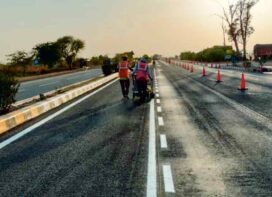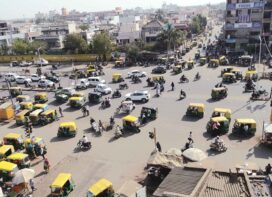
In a concerted effort involving officials from transport and police departments, road-owning agencies, medical & health professionals, and various stakeholders, the State Road Safety Cell in Rajasthan is spearheading initiatives to fulfil the Global Road Safety Goal of reducing road fatalities and severe injuries by 50% by the close of 2030. While challenges abound, strategic processes, partnerships with leading engineering institutions for technology-driven solutions, extensive awareness campaigns, collaborative endeavours with stakeholders, and a robust road safety fund collectively contribute to making this ambitious target appear attainable. Nidhi Singh, Joint Transport Commissioner (Road Safety) at the Rajasthan Transport Department, the head of this lead agency, shared insights into the diverse safety initiatives in a conversation with Trafficinfratech.
Established as the primary agency, the State Road Safety Cell comprises representatives from various departments acting as stakeholders. In 2017, the lead agency formulated the road safety policy and instituted a non-lapsable road safety fund, constituting about 25% of the annual compounding fee collection. The availability of this fund empowers the cell to undertake numerous initiatives in the field of road safety.
As the iRAD initiative progresses and technical solutions unfold, coupled with the ongoing automation of various processes, positive outcomes are anticipated in the near future. The current focus remains on infrastructure development, with results expected to follow this groundwork. I optimistically envision a safer road environment with the collective efforts of the State Road Safety Cell and its diverse stakeholders.
Integrated Road Accident Database (iRAD) App
The State Road Safety Cell utilizes the Integrated Road Accident Database (iRAD) app, provided by the Government of India, as an online accident data registry system. Rajasthan, one of the six pilot states, commenced recording data on this app in March 2021. All accidents within the state are documented on iRAD. The police department assigns a unique ID for each accident, recording relevant data, while the transport department supplements the database with information gathered during vehicle inspections. Road-owning agencies contribute details on road conditions, and the medical and health department also updates the app.
Advantages of iRAD
The Road Safety Cell operates a dedicated war room at the secretariat in Jaipur, along with Abhay Command and Control Centres in seven divisional headquarters across the state. The objective of the 112 emergency response system is to provide immediate medical and police assistance to accident victims. Major accidents prompt joint inspection reports, analyzing causes based on iRAD data and field information. The app, now featuring precise accident locations through latitude and longitude, aids in identifying accident-prone areas, enabling corrective measures such as enhanced enforcement and strategic ambulance placement.
All accidents, including manual FIRs, are recorded in iRAD. For major accidents (three or more deaths), a joint inspection report is mandated under Section 135 of the Motor Vehicles Act. Factors considered in accident analysis include iRAD data and joint inspection reports from the field.

Road Safety Web Portal
The State Road Safety Cell in collaboration with the Rajasthan Knowledge Corporation Ltd., under the department of Information and Technology, has created a road safety web portal that provides detailed information on road safety and initiatives taken by the department. It is also linked to the transport department’s website.
Road Safety Fund Initiatives
Through the road safety fund, various initiatives are being undertaken across stakeholder departments. The transport department is establishing automated driving and testing tracks at 37 locations, with 13 already operational. Portable weighing machines have been distributed to flying squads, linked to the Vahan portal. The Vehicle Location Tracking Device (VLTD) system is being installed in new buses, and funds have been allocated for its implementation in commercial vehicles and the Nirbhaya project. Additionally, funding supports the procurement of CCTV cameras and ANPR devices for the transport department.
Police Department Initiatives
The police department has received AI-based interceptors, speed radar guns, body-worn cameras, and dash cameras. Counselling centers for traffic violators have been established.

Trauma and Emergency Care
The medical and health department has been funded for skill labs through the road safety fund, and a Basic Life Support (BLS) app has been developed for free training. Collaborative training programs, such as a recent two-day session with AIIMS, New Delhi, involving 20 colleges in Jaipur, further enhance preparedness.
ITMS and Highway Development Projects
ITMS projects covering around 600 km in three stretches in Rajasthan have commenced through the Gati Shakti program of the Government of India. RISL, a subsidiary of the IT department, is installing ITMS. The lead agency is closely collaborating with the Public Works Department (PWD) on the Rajasthan State Highway development project, supported by the World Bank, featuring multiple road safety components.
Procurement Process and Decision-Making
A steering committee, led by the Additional Chief Secretary, Transport, with representation from all stakeholder departments, including the ADG Traffic, serves as the final decision-maker on road safety fund utilization. The lead agency functions as the secretariat for the committee, presenting proposals from various stakeholders for approval. While the lead agency does not handle procurement directly, proposals are forwarded to respective departments, and funds are allocated upon committee approval.
Accident Statistics and Future Plans
Current statistics lack comprehensive support for ongoing initiatives. While 2015-2018 witnessed a slight reduction in fatalities and accidents, a surge occurred in 2019. Despite a dip during the COVID years, recent trends indicate an increase in accidents in Rajasthan. The safety cell is formulating a ten-year action plan to achieve a 50% reduction in fatalities by 2030, aligning with global goals.
Collaborative discussions with IIT Jodhpur are underway to establish a Centre for Excellence, seeking technological solutions to enhance road safety conditions in the state. Collaboration with IIT Jodhpur is expected to yield positive results with technical support to the State Road Safety Cell. The ten-year action plan, part of the Rajasthan State Highway Development project, promises a more structured approach.
The integration of ambulances is an ongoing process, with the state 108 ambulance and NHAI 1033 ambulance nearing completion. Plans for the second stage involve integrating 108 with private ambulances. The agency has explored vendor presentations through the Medical and Health department.
Causes of Accidents and Behavioural Interventions
Human factors, particularly over speeding, dominate the causes of road accidents. FIRs and iRAD data consistently highlight over speeding and careless driving. Wrong-side driving is the second most significant cause, with two-wheelers being more prone to accidents, often exacerbated by non-compliance with helmet regulations. Recognizing the need for improved law enforcement and addressing road engineering defects, the safety cell aims to rectify accident causes through a comprehensive approach, including psychologists in awareness programs.
 TrafficInfraTech Magazine Linking People Places & Progress
TrafficInfraTech Magazine Linking People Places & Progress


